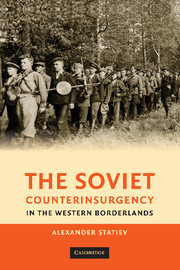Book contents
- Frontmatter
- Contents
- List of Figures
- List of Tables
- Acknowledgments
- Glossary
- Introduction
- 1 Origins of Soviet Counterinsurgency
- 2 The Borderland Societies in the Interwar Period: The First Soviet Occupation and the Emergence of Nationalist Resistance
- 3 The Borderlands under German Occupation (1941–1944): Social Context of the Soviet Reconquest
- 4 Nationalist Resistance after the Soviet Reconquest
- 5 Soviet Agrarian Policy as a Pacification Tool
- 6 Deportations, “Repatriations,” and Other Types of Forced Migration as Aspects of Security Policy
- 7 Amnesties
- 8 Red Rurales: The Destruction Battalions
- 9 Police Tactics: Actions of NKVD Security Units, Intelligence Gathering, Covert Operations, and Intimidation
- 10 The Church in Soviet Security Policy
- 11 Violations of Official Policy and Their Impact on Pacification
- 12 Conclusion: Nationalist Resistance and Soviet Counterinsurgency in the Global Context
- Appendix A Note on Used Terms and Geographic and Personal Names
- Appendix B Note on Primary Sources
- Bibliography
- Index
4 - Nationalist Resistance after the Soviet Reconquest
Published online by Cambridge University Press: 05 May 2010
- Frontmatter
- Contents
- List of Figures
- List of Tables
- Acknowledgments
- Glossary
- Introduction
- 1 Origins of Soviet Counterinsurgency
- 2 The Borderland Societies in the Interwar Period: The First Soviet Occupation and the Emergence of Nationalist Resistance
- 3 The Borderlands under German Occupation (1941–1944): Social Context of the Soviet Reconquest
- 4 Nationalist Resistance after the Soviet Reconquest
- 5 Soviet Agrarian Policy as a Pacification Tool
- 6 Deportations, “Repatriations,” and Other Types of Forced Migration as Aspects of Security Policy
- 7 Amnesties
- 8 Red Rurales: The Destruction Battalions
- 9 Police Tactics: Actions of NKVD Security Units, Intelligence Gathering, Covert Operations, and Intimidation
- 10 The Church in Soviet Security Policy
- 11 Violations of Official Policy and Their Impact on Pacification
- 12 Conclusion: Nationalist Resistance and Soviet Counterinsurgency in the Global Context
- Appendix A Note on Used Terms and Geographic and Personal Names
- Appendix B Note on Primary Sources
- Bibliography
- Index
Summary
Freedom to peoples, freedom to the individual!
– Slogan of the Ukrainian Insurgent ArmyWhen the Soviets returned to the borderlands in 1944, they encountered guerrilla war in every western region except Moldova. However, they quickly acquired thousands of supporters among those who, during the first Soviet occupation, had begun to wonder whether their position at the rural bottom was natural or fair, and also those driven to the Soviet side by German repressions and the ethnic cleansing conducted by nationalists and German collaborators. This chapter examines the social basis, strategy, and methods of the anti-Soviet resistance groups, their policies toward other nationalists and Germany, and relations between guerrillas and civilians. Though strong at the beginning of the Soviet reoccupation, the resistance was undermined gradually by Soviet pacification, disbelief in victory, strategic mistakes, and terror unleashed against peasants who complied with government regulations.
The Social Basis of the Resistance
Who fought the Communists in the western borderlands? In 1939–1941, dissent centered on the cities, and opposition consisted mainly of intellectuals, professionals, former officers, and university students. The police quickly destroyed most urban underground cells and eliminated the potential urban troublemakers by preemptive deportations. During the Soviet reoccupation of 1944, the epicenter of opposition shifted to the countryside, although its leaders still came predominantly from the urban middle and lower middle classes. In the Baltic and Polish resistance movements, former officers took the top positions.
- Type
- Chapter
- Information
- The Soviet Counterinsurgency in the Western Borderlands , pp. 97 - 138Publisher: Cambridge University PressPrint publication year: 2010



